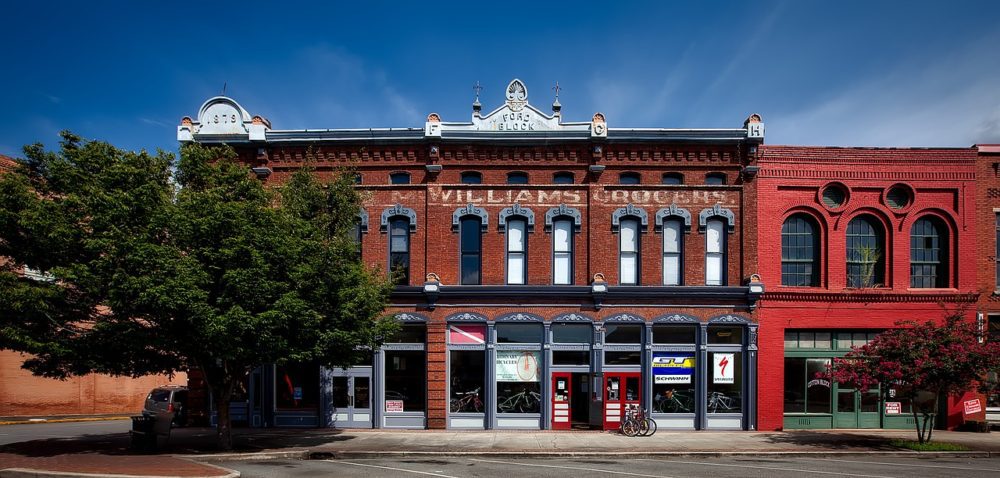
In a recent opinion piece for The New York Times called “The Myth of Main Street,” economic historian Louis Hyman tries to contextualize the disappearance of small-town America’s Main Street. And at the end, he offers a solution. Because this is an idea that preoccupies me, I was excited to read the piece.
Ninety percent of the piece is a brilliant historical analysis, followed by a solution at the end of the piece that is so horrifying I almost threw the newspaper across the room. (Yes, I was reading the print edition.) His answer to small-town America’s woes illustrates just how clueless — and screwed — we are.
“Main Street is a place but it is also an idea,” he writes. “It’s small-town retail. It’s locally owned shops selling products to hardworking townspeople.”
Yes, I like where this is going.
Trump’s campaign slogan was “Make America Great Again,” Hyman writes, but it could just as easily have been “Bring Main Street Back.”
Exactly! I grew up in small-town Kentucky, where, in the 1980s, our steel mill started laying people off, downtown stores vanished, and the town has never recovered. By the time I went to high school, it was clear: If you wanted a good job, you needed to move to a much bigger city.
Many opinion pieces pretend that this is a recent phenomenon. But instead of looking only at the past few decades, Hyman takes the long view. “You can draw a straight line from the Jeffersonians in the late 18th century to the agrarian populists in the late 19th century to Mr. Trump’s voters, all of whom have felt that the city hornswoggled the country.”
Ah, this is good writing. I need someone to put my anger at disruption-loving Silicon Valley into perspective. Urban and rural areas have always been in a tug-of-war for the hearts and minds of our country’s citizens.
“But nostalgia for Main Street is misplaced — and costly,” he writes. “Small stores are inefficient. Local manufacturers, lacking access to economies of scale, usually are inefficient as well. To live in that kind of world is expensive.”
Hyman goes on to explain how unrealistic it would be to re-create the conditions that allowed small-town America to flourish after World War II.
“This world was unsustainable,” he writes. “It unraveled in the 1960s and 1970s, as fair trade laws were repealed, manufacturers discovered overseas suppliers and unions came undone. On Main Street, prices came down for shoppers, but at the same time, so did wage growth. Main Street was officially dead.”
Got it. So that’s where we are now.
What’s the solution?
Surely an economic historian at Cornell, an intellectual with a commitment to capitalism, has some ideas that could work in America. No, we can’t stop globalization. Nor can we stop the march of technology. What’s his big idea? I can’t wait to find out.
First, he hits a note that makes me audibly cheer him on. “If the answer to rural downward mobility is to turn everyone into software engineers, there is no hope. The idea that every truck driver or coal miner can, or should, become a member of the modern professional class is closely related to the belief that unless you have those particular skills, you have no value — which isn’t the case.”
Finally!
At last, someone understands what’s really going on, and understands that not everyone is going to be a coder. I’m ready to start a fund to get this guy elected.
Then it happens.
His solution.
“Today, for the first time, thanks to the internet, small-town America can pull back money from Wall Street (and big cities more generally). Through global freelancing platforms like Upwork, for example, rural and small-town Americans can find jobs anywhere in world, using abilities and talents they already have.”
Wait … what?
“A receptionist can welcome office visitors in San Francisco from her home in New York’s Finger Lakes. Through an e-commerce website like Etsy, an Appalachian woodworker can create custom pieces and sell them anywhere in the world.
Oh, no. He’s much worse than the people who want truck drivers and coal miners to become coders and computer programmers. He wants truck drivers and coal miners to work in the gig economy.
So let’s see … Instead of your $30-per-hour factory job that you lost, you’re supposed to chase freelancing gigs online? With no salary, job security, health insurance, or retirement?
At least the highly unrealistic people promoting jobs as coders and computer programmers are pushing for a job with great salary and benefits. The median annual wage for computer programmers is about $79,530, according to the Bureau of Labor Statistics.
How about gig economy workers? Well, it depends on the city, according to Fast Company. “In Atlanta, for example, average monthly earnings dropped 10 percent between June 2015 and June 2016, landing at $647. But in Los Angeles, over the same period, earnings rose 14 percent to $960.”
Wow, you can make a whole thousand dollars a month in the gig economy? In Los Angeles, that’s almost, but not quite, enough to rent a one-bedroom apartment — with absolutely nothing left over for food, clothing, or health insurance!
And $1,000 per month in rural America isn’t much to live on, either — especially compared to what you could make at the factory. If $1,000 is the high end of what you can make in the gig economy, then a married couple working full-time hours at gig-economy jobs would bring in $24,000 a year. If you have no children, congratulations! You’re living a few thousand dollars above the federal poverty level of about $16,000 a year for a two-person household. If you have two kids, you’re living at slightly below the poverty level.
And this poverty-level existence doesn’t even take into consideration the loss of benefits.
In a speech co-sponsored last year by the Board of Governors of the Federal Reserve System, New York Fed governor Lael Brainard said, “the wages that contractors receive are unlikely to reflect the same equity considerations. Moreover, contingent work generally does not offer employer-based benefits and workplace protections that come with traditional employment opportunities, like overtime compensation, minimum wage protections, health insurance, family leave, employer-sponsored retirement plans, workers’ compensation, and paid sick leave.”
She went on, “As a result, for some, contingent work may entail greater risks than in traditional full-time employment, with more variable and less predictable hours and earnings. [One] study notes that one of freelancers’ biggest concerns is managing income variability and benefits. For lower-income workers, unpredictable fluctuations in income can lead to severe hardship. The Federal Reserve Board’s Survey of Household Economics and Decision-making, for example, finds that 46 percent of households report that they would need to borrow money or sell something in order to pay an unexpected expense of $400.”
The idea that truck drivers and coal miners are going to make it in the gig economy is an even worse idea than the hope that they’ll become computer programmers.
The unemployment rate may be hovering at around 4.5 percent, but the workforce participation rate is near historic lows of 62.7 percent.
So we’re back to some hard choices. We’re still waiting for the trillion-dollar infrastructure package. But we will also need the government to pitch in with jobs guarantees and/or wage subsidies. Federal jobs in D.C. might have to be outsourced to the rest of the country. Maybe an NSA outpost in Alabama, a CIA outpost in Michigan.
And/or Silicon Valley’s tech billionaires could decide — out of the goodness of their hearts — to dot the landscape with billion-dollar tech centers in every state.
But the gig economy, whose biggest technological innovation is to vaporize full-time jobs, is not the solution.
Sorry, Louis Hyman.


